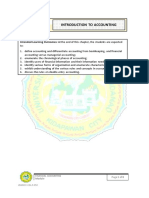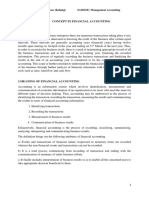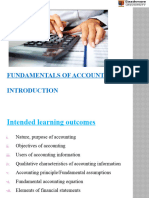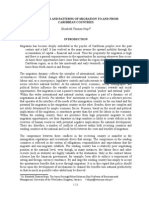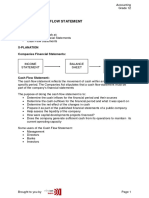UNIT-IV-Accounting Theory
UNIT-IV-Accounting Theory
Uploaded by
Narayanapally DeepikaCopyright:
Available Formats
UNIT-IV-Accounting Theory
UNIT-IV-Accounting Theory
Uploaded by
Narayanapally DeepikaOriginal Title
Copyright
Available Formats
Share this document
Did you find this document useful?
Is this content inappropriate?
Copyright:
Available Formats
UNIT-IV-Accounting Theory
UNIT-IV-Accounting Theory
Uploaded by
Narayanapally DeepikaCopyright:
Available Formats
UNIT – IV
Financial Accounting
Accounting concepts and Conventions
Accounting Equation
Double-Entry system of Accounting
Rules for maintaining Books of Accounts
Journal
Posting to Ledger
Preparation of Trial Balance
Elements of Financial Statements
Preparation of Final Accounts.
Compiled by Suresh Kumar Nayak, Asso. Prof,SoMS, NNRG
American Institute of Certified Public Accountants (AICPA) defines Accounting as “The art of
recording, classifying and summarizing in a significant manner and in terms of money
transactions and events, which are in part at least, of a financial character and interpreting
the results thereof.”
Thus, accounting is an art of identifying, recording, summarizing and interpreting business
transactions of financial nature. Hence accounting is the Language of Business.
Financial Accounting: The purpose of Accounting is to ascertain the financial results i.e.,
profit or loss in the operations during a specific period. It is also aimed at knowing the
financial position, i.e., assets, liabilities and equity position at the end of the period. It also
provides other relevant information to the management as a basic for decision-making for
planning and controlling the operations of the business.
FUNCTIONS OF AN ACCOUNTANT
1. Designing Work: It includes the designing of the accounting system, basis for
identification and classification of financial transactions and events, forms, methods,
procedures, etc.
2. Recording Work: The financial transactions are identified, classified and recorded in
appropriate books of accounts according to principles. This is “Book Keeping”. The
recording of transactions tends to be mechanical and repetitive.
3. Summarizing Work: The recorded transactions are summarized into significant form
according to generally accepted accounting principles. The work includes the
preparation of profit and loss account, balance sheet. This phase is called
‘preparation of final accounts’
4. Analysis and Interpretation Work: The financial statements are analysed by using
ratio analysis, break-even analysis, funds flow and cash flow analysis.
5. Reporting Work: The summarized statements along with analysis and
interpretation are communicated to the interested parties or whoever has the right
to receive them. For Ex. Share holders. In addition, the accounting department has
to prepare and send regular reports so as to assist the management in decision
making. This is ‘Reporting’.
Compiled by Suresh Kumar Nayak, Asso. Prof,SoMS, NNRG
6. Preparation of Budget: The management must be able to reasonably estimate the
future requirements and opportunities. As an aid to this process, the accountant has
to prepare budgets, like cash budget, capital budget, purchase budget, sales budget
etc. this is ‘Budgeting’.
7. Taxation Work: The accountant has to prepare various statements and returns
pertaining to income-tax, sales-tax, excise or customs duties etc., and file the returns
with the authorities concerned.
8. Auditing: It involves a critical review and verification of the books of accounts
statements and reports with a view to verifying their accuracy. This is ‘Auditing’
USERS OF ACCOUNTING INFORMATION
Different categories of users need different kinds of information for making
decisions. The users of accounting can be divided in two board groups (1). Internal users and
(2). External users.
Internal Users:
Managers: These are the persons who manage the business, i.e., management at
the top, middle and lower levels. Their requirements of information are different because
they make different types of decisions.
Accounting reports are important to managers for evaluating the results of their
decisions. In additions to external financial statements, managers need detailed internal
reports either branch division or department or product-wise. Accounting reports for
managers are prepared much more frequently than external reports.
Accounting information also helps the managers in appraising the performance of
subordinates. As such Accounting is termed as “the eyes and ears of management.”
4.2 External Users:
1. Investors: Those who are interested in buying the shares of company are naturally
interested in the financial statements to know how safe the investment already made is and
how safe the proposed investments will be.
2. Creditors: Lenders are interested to know whether their loan, principal and interest, will
be paid when due. Suppliers and other creditors are also interested to know the ability of
the firm to pay their dues in time.
3. Workers: In our country, workers are entitled to payment of bonus which depends on
the size of profit earned. Hence, they would like to be satisfied that the bonus being paid to
them is correct. This knowledge also helps them in conducting negotiations for wages.
Compiled by Suresh Kumar Nayak, Asso. Prof,SoMS, NNRG
4. Customers: They are also concerned with the stability and profitability of the enterprise.
They may be interested in knowing the financial strength of the company to rent it for
further decisions relating to purchase of goods.
5. Government: Governments all over the world are using financial statements for compiling
statistics concerning business which, in turn, helps in compiling national accounts. The
financial statements are useful for tax authorities for calculating taxes.
6. Public: The public at large interested in the functioning of the enterprises because it may
make a substantial contribution to the local economy in many ways including the number of
people employed and their patronage to local suppliers.
7. Researchers: The financial statements, being a mirror of business conditions, is of great
interest to scholars undertaking research in accounting theory as well as business affairs and
practices.
BASIC ACCOUNTING CONCEPTS
Accounting is a system evolved to achieve a set of objectives. In order to achieve the goals,
we need a set of rules or guidelines. These guidelines are termed here as “BASIC
ACCOUNTING CONCEPTS”. The term concept means an idea or thought. Basic accounting
concepts are the fundamental ideas or basic assumptions underlying the theory of financial
accounting. These concepts help in bringing about uniformity in the practice of accounting.
In accountancy following concepts are quite popular.
1. BUSINESS ENTITY CONEPT: In this concept “Business is treated as separate from the
proprietor”. All the Transactions recorded in the book of Business and not in the books of
proprietor. The proprietor is also treated as a creditor for the Business.
2. GOING CONCERN CONCEPT: This concept relates with the long life of Business. The
assumption is that business will continue to exist for unlimited period unless it is dissolved
due to some reasons or the other.
3. MONEY MEASUREMENT CONCEPT: In this concept “Only those transactions are recorded
in accounting which can be expressed in terms of money, those transactions which cannot
be expressed in terms of money are not recorded in the books of accounting”.
4. COST CONCEPT: According to this concept, an asset is recorded at its cost in the books of
account. i.e., the price, which is paid at the time of acquiring it. In balance sheet, these
assets appear not at cost price every year, but depreciation is deducted and they appear at
the amount, which is cost, less classification.
Compiled by Suresh Kumar Nayak, Asso. Prof,SoMS, NNRG
5. ACCOUNTING PERIOD CONCEPT: Every Businessman wants to know the result of his
investment and efforts after a certain period. Usually one-year period is regarded as an ideal
for this purpose. This period is called Accounting Period. It depends on the nature of the
business and object of the proprietor of business.
6. DUAL ASCEPT CONCEPT: According to this concept “Every business transaction has two
aspects”, one is the receiving benefit and another one is giving benefit. The receiving aspect
is termed as “DEBIT”, whereas the giving benefit aspect is termed as “CREDIT”. Therefore,
for every debit, there will be corresponding credit.
ACCOUNTING CONVENTIONS
1. FULL DISCLOSURE: According to this convention, accounting reports should disclose fully
and fairly the information. They should be prepared honestly and sufficiently disclose
information which is of material interest to all stakeholders.
2.MATERIALITY: Under this convention the trader records important factor about the
commercial activities. In the form of financial statements if any unimportant information is
to be given for the sake of clarity, it will be given as footnotes.
3.CONSISTENCY: It means that accounting method adopted should not be changed from
year to year. It means that there should be consistent in the methods or principles followed.
Or else the results of a year cannot be conveniently compared with that of another.
4. CONSERVATISM: This convention warns the trader not to take unrealized income into
account. This is the policy of “playing safe”; it takes in to consideration all prospective losses
but leaves all prospective profits.
CLASSIFICATION OF BUSINESS TRANSACTIONS
Three Types of Accounts
There are mainly three types of accounts in accounting: Real, Personal and Nominal
accounts. Personal accounts are classified into three subcategories: Artificial, Natural, and
Representative.
1. Real Accounts
All assets of a firm, which are tangible or intangible, fall under the category “Real Accounts“.
Tangible real accounts are related to things that can be touched and felt physically. Few
examples of tangible real accounts are building, machinery, stock, land, etc.
Intangible real accounts are related to things that can’t be touched and felt physically. Few
examples of such real accounts are goodwill, patents, trademarks, etc.
Compiled by Suresh Kumar Nayak, Asso. Prof,SoMS, NNRG
Golden rule for real accounts: Debit what comes in, Credit what goes out
Example-Purchased furniture for 10,000 in cash
Accounts Involved- Furniture A/C, Cash A/C
Both are real accounts. As Furniture is coming in, hence it is to be debited. As cash is going
out, it is to be credited.
2. Personal Accounts
These accounts are related to individuals, firms, companies, etc. A few examples of personal
accounts include debtors, creditors, banks, outstanding/prepaid accounts, capital, drawings,
etc.
Natural personal accounts: This type of personal accounts is the simplest to understand out
of all and includes all God’s creations who have the ability to deal, who, in most cases, are
people. E.g. Kumar’s A/C, Adam’s A/C, etc.
Artificial personal accounts: Personal accounts which are created artificially by law, such as
corporate bodies and institutions, are called artificial personal accounts. E.g. Pvt Ltd
companies, Banks, LLCs, LLPs, clubs, schools, etc.
Representative personal accounts: Accounts which represent a certain person or a group
directly or indirectly. E.g. let’s say that wages are paid in advance to an employee – a wage
prepaid account will be opened in the books of accounts. This wages prepaid account is a
representative personal account indirectly linked to the person. Other examples are any
outstanding expenses, accrued income, prepaid expenses, Income received in advance.
Golden rule for personal accounts-Debit the receiver, Credit the giver
Example-Paid Nirajl Pvt Ltd. 24,000 by check
Accounts Involved Niraj Pvt Ltd, Bank A/C .Both are artificial person. As Niraj Limited is
receiving, hence must be debited. As bank is giving, must be credited.
3. Nominal Accounts
Accounts which are related to expenses, losses, incomes or gains are called Nominal
accounts. E.g. Purchase A/C, Salary A/C, Sales A/C, Commission received A/C, etc.
Golden rule for nominal account-Debit all expenses & losses, Credit all incomes & gains
Example-The following example shows a transaction where a nominal account deals with a
real a/c.
Purchased good for 15,000 in cash
Compiled by Suresh Kumar Nayak, Asso. Prof,SoMS, NNRG
Accounts Involved- Purchase A/C and Cash A/C. While purchase account is Nominal, Cash
is a real account. As purchase is an expenses, it must be debited.Similarly, applying the rules
of real account, as cash is going out, it is credited.
JOURNAL
The first step in accounting therefore is the record of all the transactions in the books of
original entry viz., Journal and then posting into ledges. The word Journal is derived from
the Latin word ‘journ’ which means a day. Therefore, journal means a ‘day Book’ in which
day-to-day business transactions are recorded in chronological order.
Journal is treated as the book of original entry or first entry or prime entry. All the business
transactions are recorded in this book before they are posted in the ledges. The journal is a
complete and chronological (in order of dates) record of business transactions. It is recorded
in a systematic manner. The process of recording a transaction in the journal is called
“JOURNALISING”. The entries made in the book are called “Journal Entries”.
The proforma of Journal is given below.
Date Date Particulars L.F. no Debit Credit
RS. RS.
1998 Jan 1 Purchases account to cash 10,000/- 10,000/-
account(being goods
purchased for cash)
LEDGER
All the transactions in a journal are recorded in a chronological order. After a certain period,
if we want to know whether a particular account is showing a debit or credit balance it
becomes very difficult. So, the ledger is designed to accommodate the various accounts
maintained the trader. It contains the final or permanent record of all the transactions in
duly classified form. “A ledger is a book which contains various accounts.” The process of
transferring entries from journal to ledger is called “POSTING”.
Posting is the process of entering in the ledger the entries given in the journal. Posting into
ledger is done periodically, may be weekly or fortnightly as per the convenience of the
business. The following are the guidelines for posting transactions in the ledger.
1. After the completion of Journal entries only posting is to be made in the ledger.
2. For each item in the Journal a separate account is to be opened. Further, for each
new item a new account is to be opened.
3. Depending upon the number of transactions space for each account is to be
determined in the ledger.
4. For each account there must be a name. This should be written in the top of the
table. At the end of the name, the word “Account” is to be added.
Compiled by Suresh Kumar Nayak, Asso. Prof,SoMS, NNRG
5. The debit side of the Journal entry is to be posted on the debit side of the account,
by starting with “TO”.
6. The credit side of the Journal entry is to be posted on the debit side of the account,
by starting with “BY”.
Proforma for ledger: LEDGER BOOK
Sales Account
Date Particulars LF No Amount Date Particulars LF No amount
TRAIL BALANCE
A trail balance is a statement of debit and credit balances. It is prepared on a particular date
with the object of checking the accuracy of the books of accounts. It indicates that all the
transactions for a particular period have been duly entered in the book, properly posted and
balanced. A trail balance is a list of all the balances standing on the ledger accounts and
cash book of a concern at any given date.
PROFORMA FOR TRAIL BALANCE:
Trail balance for XYZ Ltd as on31/12/2019
Debit Credit
Particulars
(Amount in Rs) (Amount in Rs)
Stock XXXX
Sales XXXX
Purchases XXXX
Creditors XXXX
Trade Expenses XXXX
Bills payable XXXX
Salary XXXX
Discount XXXX
Carriage outwards XXXX
Capital XXXX
Debtors XXXX
Plant and Machinery XXXX
Cash at bank XXXX
Rent and rates XXXX
Outstanding expenses XXXX
Total XXXXXXX XXXXXXX
Compiled by Suresh Kumar Nayak, Asso. Prof,SoMS, NNRG
After having checked the accuracy of the books of accounts through preparation of Trial
Balance, The Final Accounts’ which are also termed as ‘Financial Statement’ are prepared to
ascertain the profit earned or loss suffered during the year and also the financial position of
business at the end of the year. The financial statement consists of Income Statement and
Balance Sheet. An Income Statement has two parts namely,
1. Trading Account - It reveals gross profit or gross loss and
2. Profit and Loss Account - It reveals net profit or net loss.
3. Balance Sheet-It discloses the financial position of business on a particular date.
Hence financial statement means Trading Account and Profit and Loss Account, Balance
sheet.
Trading Account
Trading Account is the first stage in the process of preparing final accounts. Trading account
shows the gross profit or gross loss during an accounting year which is finally transferred to
the Profit and Loss Account
All expenses which relate to either purchase of raw material or manufacturing of goods are
recorded in the Trading Account. All such expenses are called ‘Direct Expenses’.
Profit and Loss Account
Profit and Loss Account is prepared to calculate the net profit or net loss of the business for
a given accounting period. “A Profit and Loss Account is an account into which all gains and
losses are collected in order to ascertain the excess of gains over the losses or vice versa” -
Prof. Carter
The Profit and Loss Account starts with the credit from the Trading Account in respect of
gross profit (or debit if there is gross loss). Thereafter, all indirect expenses and losses are
debited to the Profit and Loss Account. Indirect expenses include all administration, selling
and distribution expenses such as salaries, rent and taxes, postage, and stationery,
insurance, depreciation, interest paid, office lighting, advertising, packing, carriage
outwards, etc. Losses include items like loss by fire, loss by theft, etc. If there is any income
and gain besides the gross profit, it will also be transferred to the credit of the Profit and
Loss Account. The difference of the two sides of this account is either net profit or net loss
which is transferred to the capital account of the proprietors. Net profit increases the capital
or net loss decreases the capital.
Compiled by Suresh Kumar Nayak, Asso. Prof,SoMS, NNRG
Balance Sheet
The Balance Sheet is a statement at a particular date showing on one side the trader’s
property and possessions and on the other hand the liabilities. It contains balances of all the
personal and real accounts which are grouped as assets and liabilities. Liabilities are shown
on the left-hand side o the Balance Sheet and assets on the right-hand side.
Need and Importance of Preparing a Balance Sheet
• The purposes of preparing a Balance Sheet are as follows:
• The main purpose of preparing a Balance Sheet is to ascertain the true financial
position of the business at a particular point of time.
• It helps in ascertaining the nature and cost of various assets o the business such as
the amount of Closing Stock, amount owing from Debtors, amount of fictitious
assets etc.
• It helps in determining the nature and amount of various liabilities of the business.
• It gives information about the exact amount of capital at the end of the year and the
addition or deduction made into it in the current year.
• It helps in finding out whether the firm is solvent or not. The firm is solvent if the
assets exceed the external liabilities. It would be insolvent if opposite is the case.
• It helps in preparing the Opening Entries at the beginning of the next year.
Difference between Trial Balance and Balance Sheet
S.No. Basis of Trial Balance Balance Sheet
Difference
1. Object It is prepared to check the It is prepared to know the true
arithmetical accuracy of the financial position of the firm.
books of accounts.
2. Necessity Though desirable, its preparation It is necessary to prepare a
is not necessary. Balance Sheet.
3. Headings The headings of its two columns The headings of its two sides
are debit and credit. are assets and liabilities.
4. Types of All types of accounts whether Only personal and real accounts
Accounts personal, real or nominal must are included in it.
be written in it.
Compiled by Suresh Kumar Nayak, Asso. Prof,SoMS, NNRG
5. Adjustments It can be prepared without It cannot be prepared without
making adjustments for making adjustments for
outstanding expenses, prepaid outstanding expenses, prepaid
expenses, accrued incomes etc. expenses, accrued incomes etc.
6. Evidence It is not accepted by the court as It is accepted by the court as
documentary evidence. documentary evidence. It is also
helpful while making payment
of income-tax and sales-tax.
Proforma of a Trading, Profit & Loss A/C and Balance Sheet
Trading and profit Loss Account of xyz Ltd for the Year ending 31-12-2020
Dr Cr
Particulars Amount in Rs Particulars Amount in Rs
To opening Stock xxxx By Sales xxxx
To Purchase xxxx Less-Returns xxxx xxxx
Less-Returns xxxx xxxx By Closing Stock xxxx
To Carriage xxxx
To wages xxxx
To freight xxxx
To Gross profit
c/d(Balancing Figure) xxx
Total xxxxxxx Total xxxxxx
To Trade Expenses By Gross Profit b/d xxxx
To Salary xxxx By Dicount xxxx
To Discount xxxx
To Carriage outwards xxxx
To rent and rates xxxx
To Depreciation xxxx
To Net Profit transferred
to Capital A/C xxxx
Total xxxxxxx Total xxxxxxx
Compiled by Suresh Kumar Nayak, Asso. Prof,SoMS, NNRG
Balance Sheet of xyz Ltd as on 31st December 2020
Amount in Amount in
Liability Rs Assets Rs
Capital xxxxx Debtors xxxxx
Add-Net Profit xxx xxxxx Plant and Machinery xxxxx
Creditors xxxxx Less-Depreciation xxx xxxxx
Bills Payable xxxxx Cash at Bank xxxxx
Outstanding
expenses xxxxx Business Premises xxxxx
Marketable
Bank Overdraft xxxxx Securities xxxxx
Outstanding Wages xxxxx Prepaid Rent xxxxx
Outstanding Salary xxxxx Closing Stock xxxxx
Total xxxxx Total xxxxx
Preparation of Final Accounts with Adjustments
1. Closing Stock
Normally, closing stock appears as an adjustment entry in the problem and is given at the
end of the trial balance. The two-fold effect of this entry will be:
(i) Stock will have a debit balance. Being a real account, it will be shown on the assets
side of the Balance Sheet.
(ii) Closing stock will be shown on the credit side of the Trading Account.
If Closing Stock appearing only in the Trial Balance, then it will be shown on the assets side
of the balance sheet because closing stock is a real account.
2. Outstanding Expenses
There are certain expenses, which have been incurred but not paid. These expenses are
called outstanding expenses. For example, salary to the clerk Rs. 10,000 is due for the
month of December. The two fold effect of this entry will be:
(i) Outstanding expenses will be added to that particular expenses account, if any, on the
debit side of Profit & Loss Account.
(ii) Outstanding Expenses Account, being personal and having credit balance, will be shown
on the liabilities side of the Balance Sheet.
Compiled by Suresh Kumar Nayak, Asso. Prof,SoMS, NNRG
If outstanding expenses only appears in trial balance, then it will be shown on the liabilities
side of the Balance Sheet.
3. Prepaid or Unexpired Expenses
Those expenses which have been paid, in full, but their utility or benefit has not expired
during the accounting period are called prepaid or unexpired expenses. In other words,
amount has been paid even for the period subsequent to the balance sheet date. For
example, insurance Rs. 12,000 is paid on 1st July, where accounting year closes on 31st
December.
The double effect of this adjusting entry will be:
(i) Prepaid expenses will be deducted from that particular expenses account on the debit
side of the Profit & Loss Account.
(ii) Prepaid expenses, being personal account and having debit balance, will be shown on
the assets side of the Balance Sheet
If only appears in trial balance, then it will be shown on the asset side of the Balance Sheet.
4. Accrued Income
Income earned but not received during the accounting period is called accrued Income.
The two fold effect of this entry will be:
(i) Accrued income will be added to the income account on the credit side of the profit &
loss account.
(ii) Accrued income, being personal account and having debit balance, will be shown on
the debit side of the Balance Sheet.
If only appears in trial balance, then it will be shown on the asset side of the Balance Sheet
5. Unearned Income or Income Received in Advance
Sometimes, the amount received in respect of an income during the year pertains, partially,
to the next year. The two fold effect of this entry will be:
(i) Unearned income will be deducted from that particular income account on the credit side
of the Profit & Loss Account.
(ii) Unearned income, being personal account and having credit balance, will be shown on
the liability side of the Balance Sheet
Compiled by Suresh Kumar Nayak, Asso. Prof,SoMS, NNRG
If only appears in trial balance, then it will be shown on the liability side of the Balance
Sheet.
6. Depreciation
The value of fixed assets goes on reducing year by year because of wear, tear and efflux of
time. This fall in the value should be treated as a loss or expense, to be considered before
profit or loss is ascertained. The value to be shown in the Balance Sheet must also be,
suitably, reduced. The two fold effect of this entry will be:
i. Depreciation is debited to the Profit & Loss Account
ii. The concerned asset will appear at its reduced value in the balance sheet.
If only appears in trial balance, then it will be shown on the debit side of the profit and loss
account.
7. Interest on Capital
The proprietor may wish to ascertain his profit, after considering the interest for the
amount invested in the firm. Suppose, the capital is Rs. 2,00,000 and the rate of interest is
5%. Then, the interest will be Rs. 10,000. It will be treated like other expenses and debited
to the Profit and Loss Account; the amount will also be credited to the Capital Account.
8. Interest on Drawings
The proprietor may also realize that when he draws money for private use, the firm loses
interest as funds for business are reduced. Therefore, the proprietor’s capital may be
reduced with the amount of interest and Profit and Loss Account will be credited with that
amount.
9. Interest on Loan
Interest must be paid on loans, whether there is profit or loss. It is calculated by reference
to the rate of interest agreed to be paid by the firm. The amount of the interest to be paid
is to be debited Profit and Loss Account and it will be shown in the liability side of balance
sheet as Outstanding Interest Account.
Compiled by Suresh Kumar Nayak, Asso. Prof,SoMS, NNRG
You might also like
- Accounting NotesDocument23 pagesAccounting Notesboiroy100% (4)
- Accounting NotesDocument22 pagesAccounting NotesSrikanth Vasantada50% (4)
- MBA Financial AccountingDocument57 pagesMBA Financial AccountingNaresh Guduru100% (1)
- Industrial Relations, Labour La - Meenakshi BaruaDocument104 pagesIndustrial Relations, Labour La - Meenakshi BaruaShaivy VarshneyNo ratings yet
- MCWS Ecotourism Management Plan, Final - LAC - 26dec2018 (Edited)Document163 pagesMCWS Ecotourism Management Plan, Final - LAC - 26dec2018 (Edited)Robert P. Duquil100% (2)
- Fa Unit 1 - Notes - 20200718004241Document21 pagesFa Unit 1 - Notes - 20200718004241Vignesh CNo ratings yet
- Unit Iv BefaDocument20 pagesUnit Iv Befapramod rockzNo ratings yet
- MEFA Unit VDocument29 pagesMEFA Unit VSusmitha ChakkaNo ratings yet
- FA Unit1Document53 pagesFA Unit1isha20raoNo ratings yet
- Unit-I: SVD & SGL College of Management and Technology: RajahmundryDocument38 pagesUnit-I: SVD & SGL College of Management and Technology: RajahmundryHappyPrinceNo ratings yet
- 413 Block1Document208 pages413 Block1Subramanyam Devarakonda100% (1)
- FM& EE Module-2 Theory NotesDocument13 pagesFM& EE Module-2 Theory NotesDavid KiranNo ratings yet
- Mefa Unit 5Document32 pagesMefa Unit 5Saalif RahmanNo ratings yet
- Accounting NotesDocument26 pagesAccounting Notesmusa kalumbaNo ratings yet
- Handout Basic Accounting Concepts PDFDocument7 pagesHandout Basic Accounting Concepts PDFVįswáją KáŋnàNo ratings yet
- Unit 1 KMBN103Document16 pagesUnit 1 KMBN103Anuj YadavNo ratings yet
- Unit - 1 Introduction To AccountingDocument17 pagesUnit - 1 Introduction To Accountingvrindadevadas0624No ratings yet
- Smu Account Assignment SolvedDocument323 pagesSmu Account Assignment SolvedAnupam Rana100% (1)
- Accounting For Managers Sessions 1 - 10Document24 pagesAccounting For Managers Sessions 1 - 10Nishant SinghNo ratings yet
- MBA-AFM Theory QBDocument18 pagesMBA-AFM Theory QBkanikaNo ratings yet
- Rac 101 - Introduction Continued (Week 3)Document11 pagesRac 101 - Introduction Continued (Week 3)Kevin TamboNo ratings yet
- 11 Accountancy Theory - 2022-23 (EM)Document36 pages11 Accountancy Theory - 2022-23 (EM)kms195kds2007No ratings yet
- Unit 1 Introduction To AccountingDocument41 pagesUnit 1 Introduction To Accountingtimepassstuff123No ratings yet
- Advanced Financial Management: AssignmentDocument11 pagesAdvanced Financial Management: AssignmentGiri SachinNo ratings yet
- Learning Objctives Basic Concepts in Accounting Journal Ledger Cash Books Trial Balance Preperation of Finan AccountsDocument23 pagesLearning Objctives Basic Concepts in Accounting Journal Ledger Cash Books Trial Balance Preperation of Finan Accounts254452No ratings yet
- Financial Accounting UNIT-1Document21 pagesFinancial Accounting UNIT-1Gowthami GowthuNo ratings yet
- MEFA UNIT-4 and UNIT 5 NotesDocument26 pagesMEFA UNIT-4 and UNIT 5 NotesRishitha ReddyNo ratings yet
- Financial Accounting For Managers Unit 1 Mba Sem 1Document13 pagesFinancial Accounting For Managers Unit 1 Mba Sem 1Mohit TripathiNo ratings yet
- Kipm 031123040550Document20 pagesKipm 031123040550shubhamshukla412No ratings yet
- Accounting & Financial Management Mca 405ADocument22 pagesAccounting & Financial Management Mca 405ANaveen Kumar reddy ENo ratings yet
- Financial Accounting FrameworkDocument45 pagesFinancial Accounting Frameworkajit_satapathy1988No ratings yet
- Theoretical Framework of Financial AccountingDocument9 pagesTheoretical Framework of Financial AccountingramalingamneelavathiNo ratings yet
- Accounting For Managers-Unit-1Document21 pagesAccounting For Managers-Unit-1VenkateshNo ratings yet
- Accounting Theory Handout 1Document43 pagesAccounting Theory Handout 1Ockouri Barnes100% (4)
- Introduction To AccountingDocument19 pagesIntroduction To Accountingkarn.sakshi05No ratings yet
- Notes Introduction To Accounting of Chapter 1Document6 pagesNotes Introduction To Accounting of Chapter 1amaan 10 BNo ratings yet
- Fama - Unit 1Document10 pagesFama - Unit 1Shivam TiwariNo ratings yet
- Accounting Notes For EE SubjectDocument32 pagesAccounting Notes For EE SubjectSanjay YadavNo ratings yet
- Term1 Cycle 1 Notes On Chapter 1 Xi AccountancyDocument5 pagesTerm1 Cycle 1 Notes On Chapter 1 Xi AccountancyCelestialNo ratings yet
- Concept of Accounting:: AdvertisementsDocument13 pagesConcept of Accounting:: AdvertisementsSanthu bm97No ratings yet
- Accounts 1Document14 pagesAccounts 1Piyush PatelNo ratings yet
- Accounting and Business - Part IDocument38 pagesAccounting and Business - Part IJaymark LigcubanNo ratings yet
- BEFA - Unit-4 NotesDocument43 pagesBEFA - Unit-4 Notesmadddy0769No ratings yet
- English Accounting NotesDocument20 pagesEnglish Accounting NotesgunapalshettyNo ratings yet
- ADMDocument418 pagesADMK A N N A NNo ratings yet
- FINANCIAL ACCOUNTING Notes PDFDocument134 pagesFINANCIAL ACCOUNTING Notes PDFMix Mixture75% (4)
- Subject Financial Accounting and Reporting Chapter/Unit Chapter 2/part 1 Lesson Title Accounting and Business Lesson ObjectivesDocument16 pagesSubject Financial Accounting and Reporting Chapter/Unit Chapter 2/part 1 Lesson Title Accounting and Business Lesson ObjectivesAzuma JunichiNo ratings yet
- FinAcc Chapter 1Document8 pagesFinAcc Chapter 1IrmaNo ratings yet
- Wa0003.Document14 pagesWa0003.souravrathod7No ratings yet
- 1.Overview of AccountingDocument19 pages1.Overview of AccountingPriyanshi JhaNo ratings yet
- SLM Unit 01 MBF104Document25 pagesSLM Unit 01 MBF104Divya Kishan B RNo ratings yet
- Chapter 1 Introduction To AccountingDocument17 pagesChapter 1 Introduction To Accountingpriyam.200409No ratings yet
- Introduction To AccountingDocument4 pagesIntroduction To Accountingkrishiv malkaniNo ratings yet
- Concept in Financial AccountingDocument15 pagesConcept in Financial AccountingUdit RajNo ratings yet
- Accounts Chapter 1 NotesDocument3 pagesAccounts Chapter 1 Noteshkaurr08No ratings yet
- Acc Ch1 NotesDocument5 pagesAcc Ch1 Notessupriyapandey0207No ratings yet
- Lecture 1 Introduction To AccountingDocument72 pagesLecture 1 Introduction To AccountingLinnea KulunduNo ratings yet
- Accounting Process and PrinciplesDocument33 pagesAccounting Process and PrinciplesDolly DollNo ratings yet
- Module 1 - Accounting and BusinessDocument16 pagesModule 1 - Accounting and BusinessNiña Sharie Cardenas100% (1)
- ABM - FABM11 IIIa 5Document4 pagesABM - FABM11 IIIa 5Kayelle BelinoNo ratings yet
- "The Language of Business: How Accounting Tells Your Story" "A Comprehensive Guide to Understanding, Interpreting, and Leveraging Financial Statements for Personal and Professional Success"From Everand"The Language of Business: How Accounting Tells Your Story" "A Comprehensive Guide to Understanding, Interpreting, and Leveraging Financial Statements for Personal and Professional Success"No ratings yet
- CF Mock1Document7 pagesCF Mock1Pujitha PuppalaNo ratings yet
- PPT On Opening Bank AccountDocument15 pagesPPT On Opening Bank Accountshiva kumar100% (1)
- Bitter Sweet: Child Labor in The Chocolate Industry - A Clear Case of Double Standards?Document27 pagesBitter Sweet: Child Labor in The Chocolate Industry - A Clear Case of Double Standards?Jhon Ray RabaraNo ratings yet
- Apple Entrance in VietnamDocument18 pagesApple Entrance in VietnamTrần Tố QuyênNo ratings yet
- Thomas HopeDocument22 pagesThomas HopeMark MohommedNo ratings yet
- CLC Business Case For Workplace DiversityDocument7 pagesCLC Business Case For Workplace DiversityShrutiBindalNo ratings yet
- Acquisition of Assets: Asset ManagementDocument3 pagesAcquisition of Assets: Asset Managementnomaan khanNo ratings yet
- Balance Sheet of Dabur India LTDDocument15 pagesBalance Sheet of Dabur India LTDAshish JainNo ratings yet
- Mid Term Quiz 2 On Cost Accounting and Control - Manufacturing Overhead - DepartmentalizationDocument3 pagesMid Term Quiz 2 On Cost Accounting and Control - Manufacturing Overhead - DepartmentalizationGabriel Adrian ObungenNo ratings yet
- Q8 IM05 FinalDocument35 pagesQ8 IM05 FinalJb MacarocoNo ratings yet
- Chapter 11Document37 pagesChapter 11Tamru gebregeorgisNo ratings yet
- Karnataka Economic Survey 2021-22-m2 - Eng - FinalDocument895 pagesKarnataka Economic Survey 2021-22-m2 - Eng - FinalsupreethsdNo ratings yet
- BCC BR 107 127Document182 pagesBCC BR 107 127DasthagiriBhashaNo ratings yet
- CH 1 Lesson 1Document39 pagesCH 1 Lesson 1LM Fernandez100% (1)
- Assignment 2: Chain Management at Durham International Manufacturing Company 1Document5 pagesAssignment 2: Chain Management at Durham International Manufacturing Company 1Esh AlexNo ratings yet
- Effects of Public Expenditure On Economy Production DistributionDocument2 pagesEffects of Public Expenditure On Economy Production DistributionPeter NdiranguNo ratings yet
- MKT420 Assignment - Business Analysis On 4P's Mini ReportDocument5 pagesMKT420 Assignment - Business Analysis On 4P's Mini ReportNurdini HusinNo ratings yet
- Debt Crisis in GreeceDocument9 pagesDebt Crisis in GreeceHải TrầnNo ratings yet
- Complete PrivatizationDocument3 pagesComplete PrivatizationNaziRulJoehaRyNo ratings yet
- MM Chapter 5 Test BankDocument8 pagesMM Chapter 5 Test BankkarimNo ratings yet
- (23537779 - Production Engineering Archives) The Use of QFD Method Advantages and LimitationDocument4 pages(23537779 - Production Engineering Archives) The Use of QFD Method Advantages and LimitationFikryNo ratings yet
- 2019 Serve 360 Report PDFDocument91 pages2019 Serve 360 Report PDFDaniela DranganagiuNo ratings yet
- Gross Private Domestic Investment (GPDI) : ConsumptionDocument7 pagesGross Private Domestic Investment (GPDI) : ConsumptionkavinkumarjackNo ratings yet
- Policy Guideline No. 1 of 2021-PNGGPDocument1 pagePolicy Guideline No. 1 of 2021-PNGGPSatyam KrishnaNo ratings yet
- Hero Honda Motors LTD.: A Project Report OnDocument37 pagesHero Honda Motors LTD.: A Project Report OnshashisaklaniNo ratings yet
- 125 FdocDocument11 pages125 Fdocsunkist0091No ratings yet
- Principles of Marketing Chapter 8Document36 pagesPrinciples of Marketing Chapter 8Mahmud AhmedNo ratings yet
- 100% Decentralized First Ever Matrix Project: Forsage - IoDocument13 pages100% Decentralized First Ever Matrix Project: Forsage - Iokrir100% (1)















































